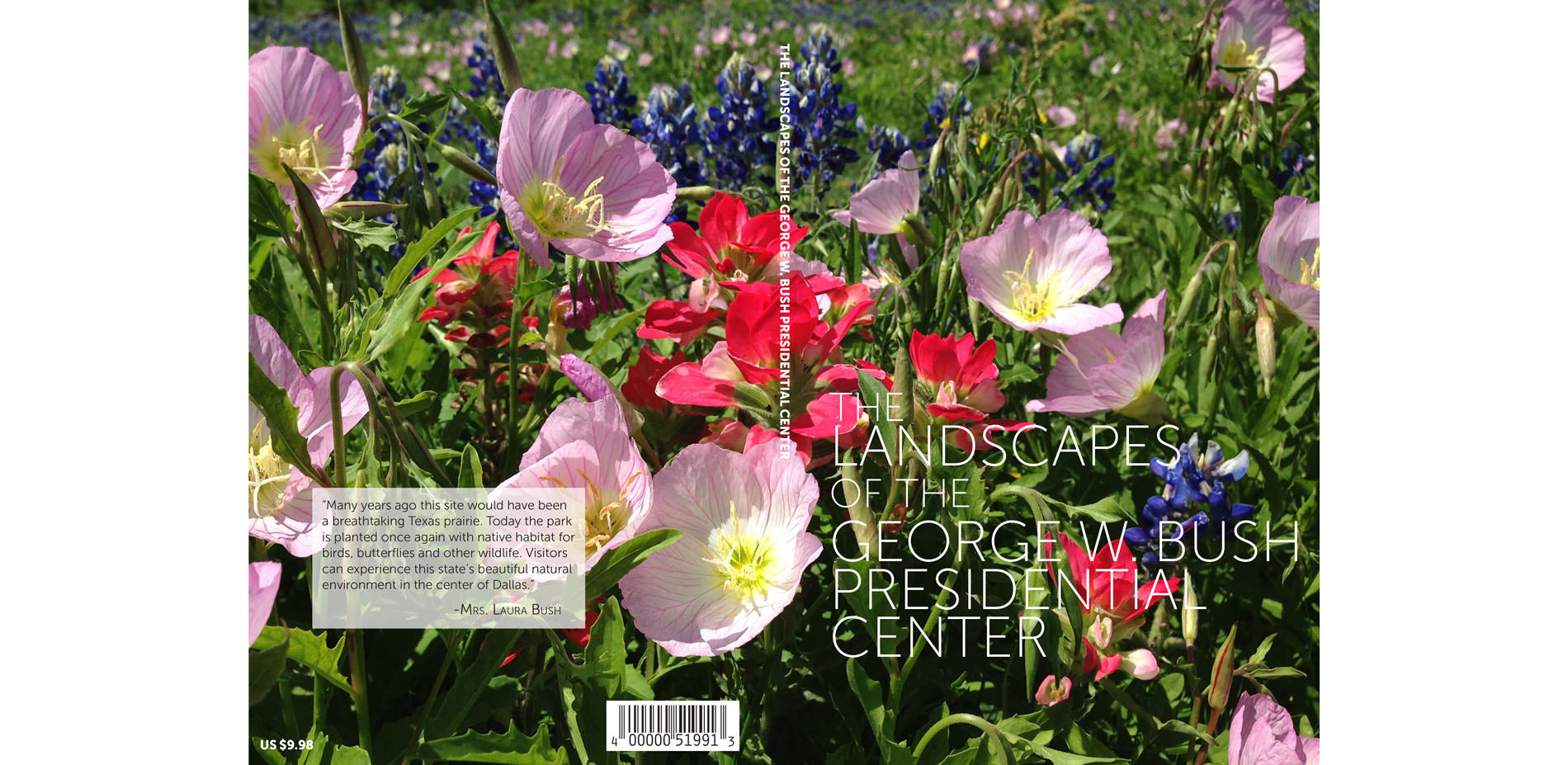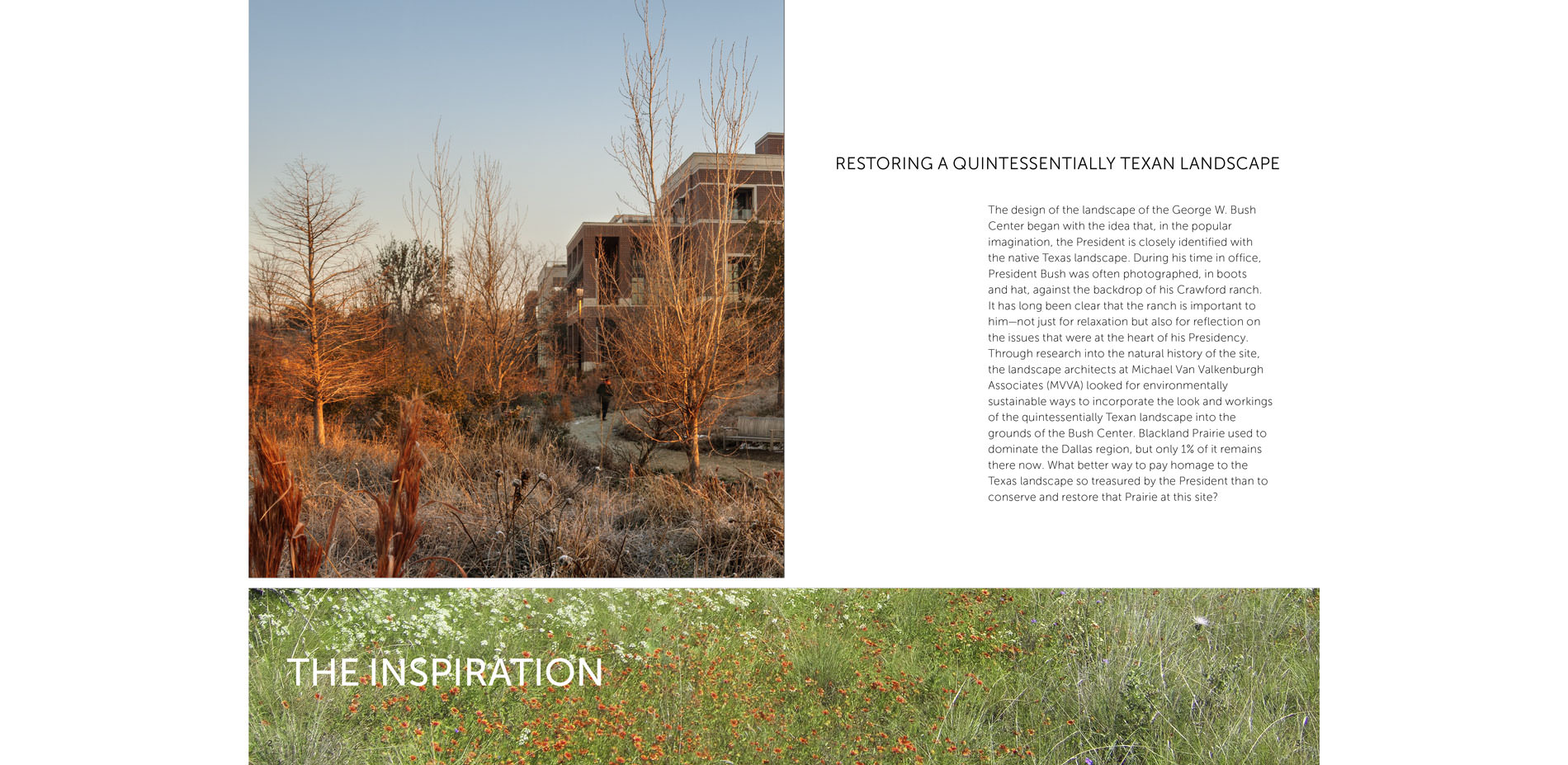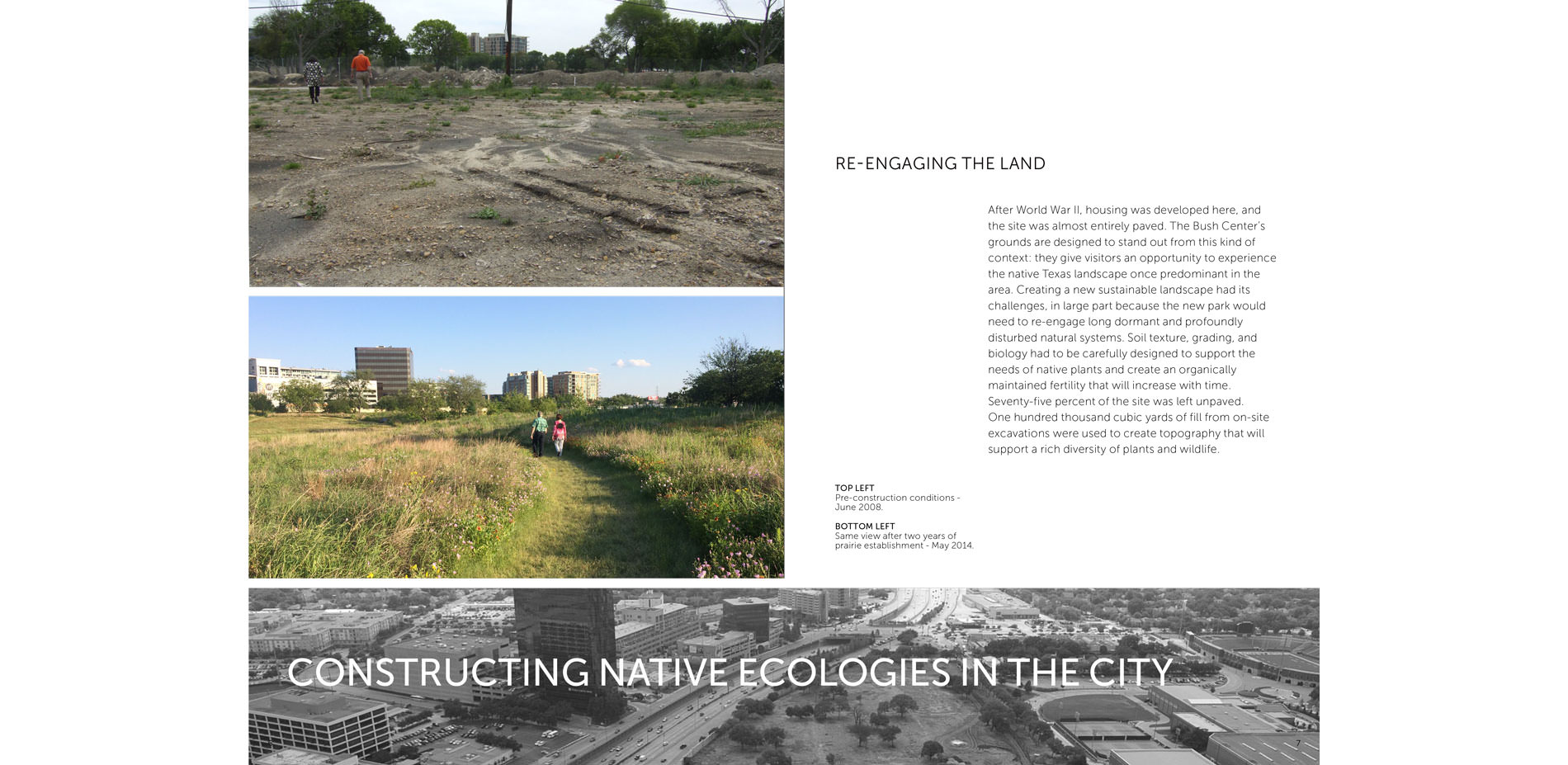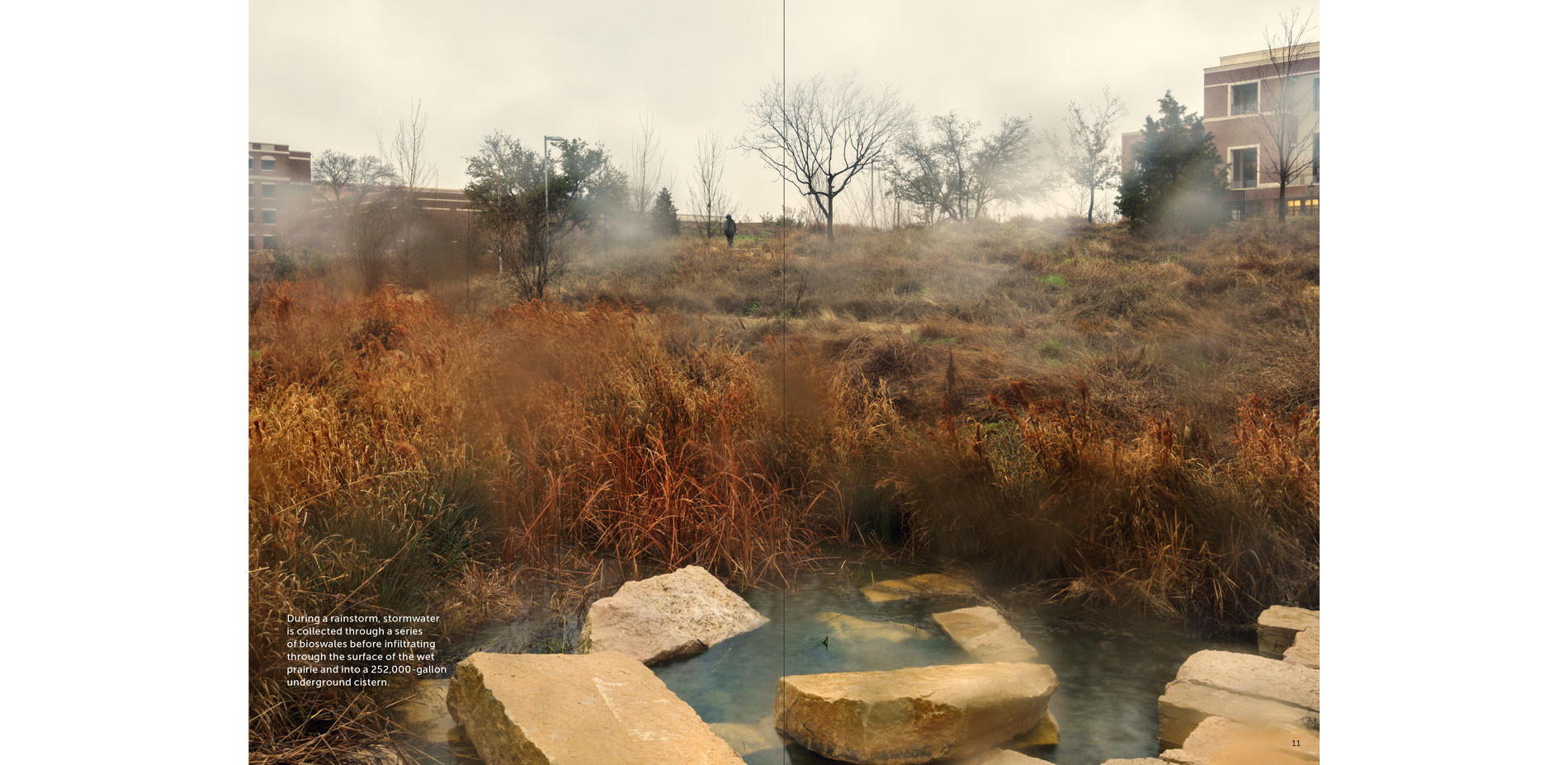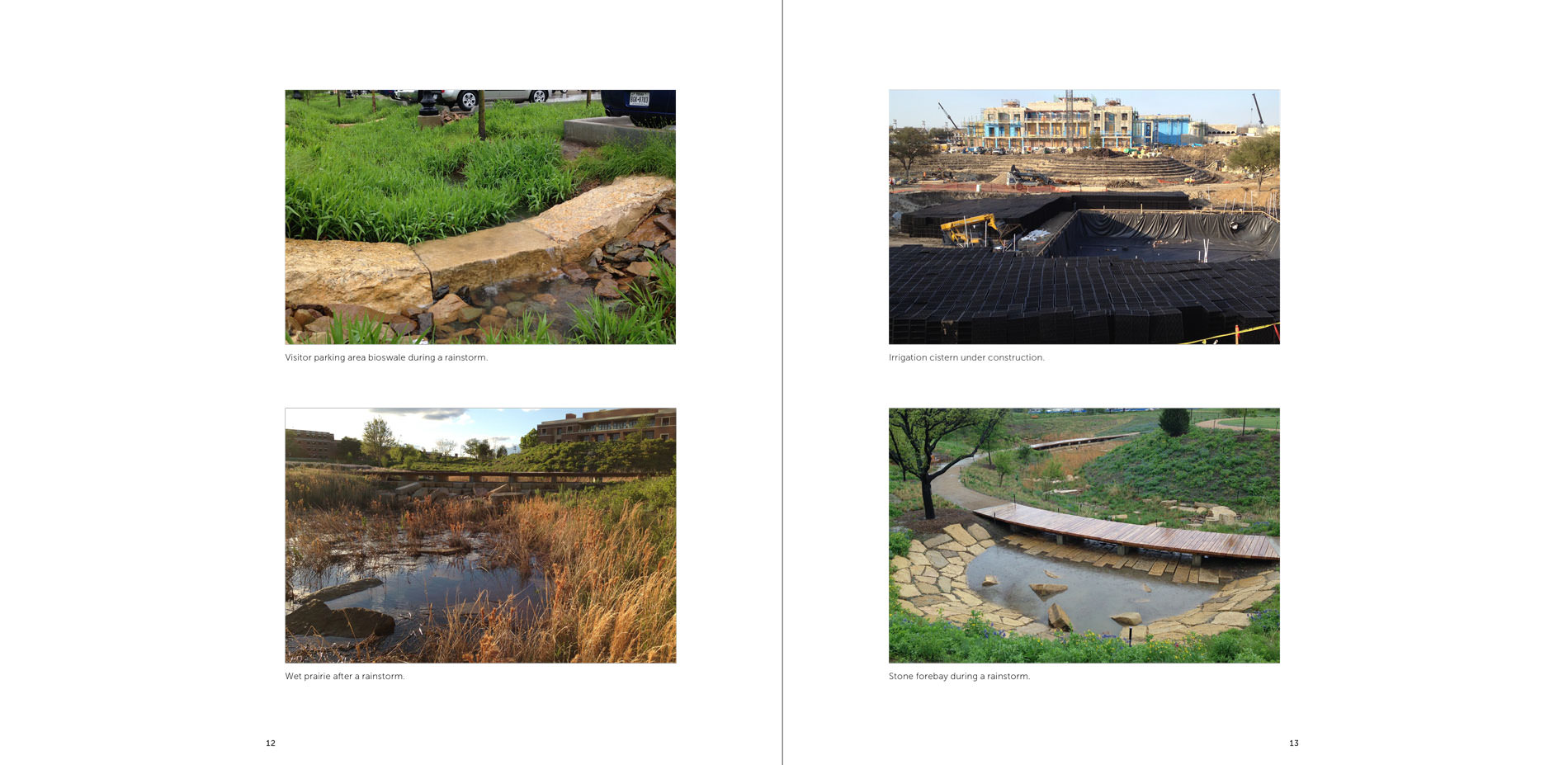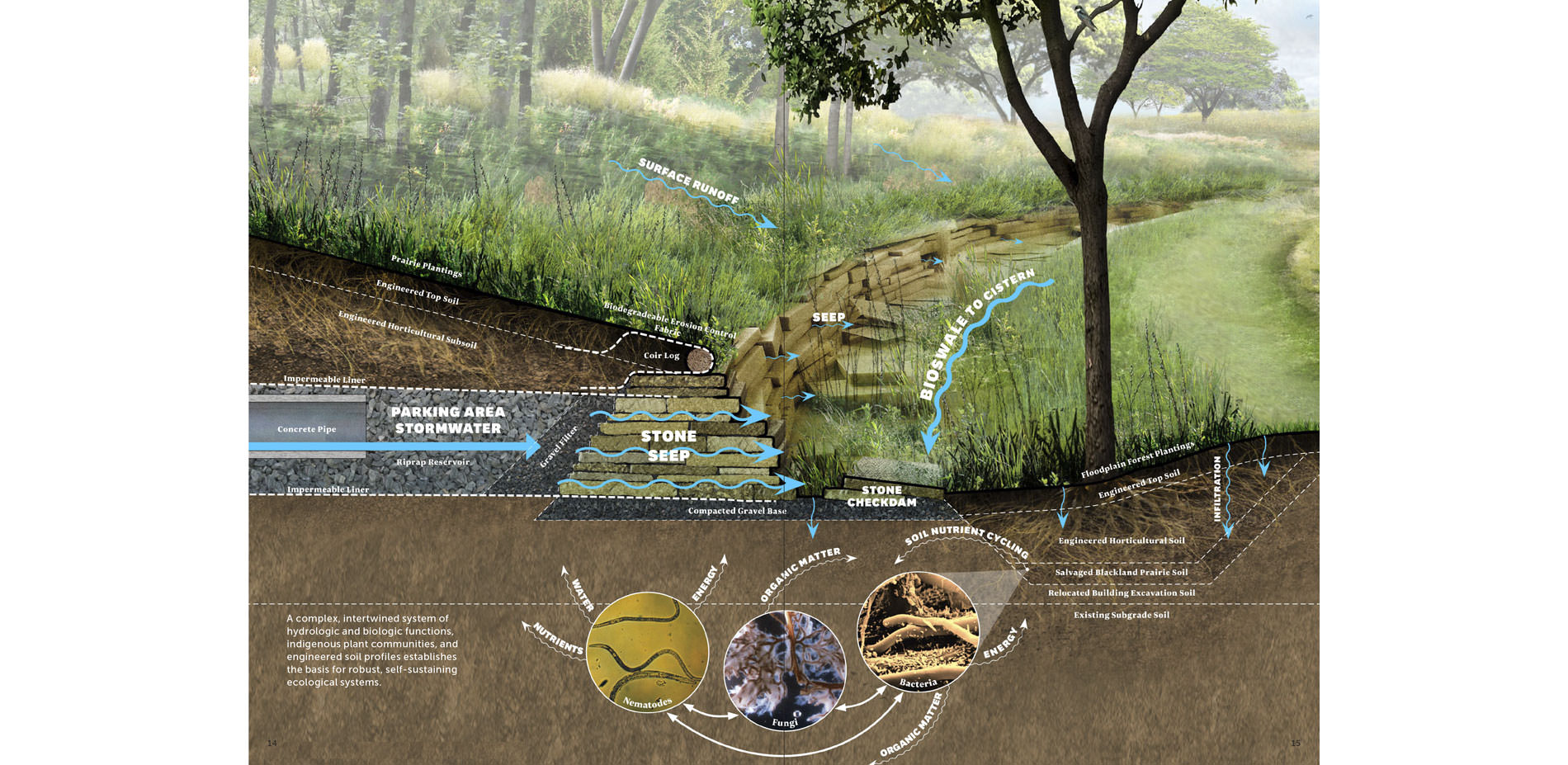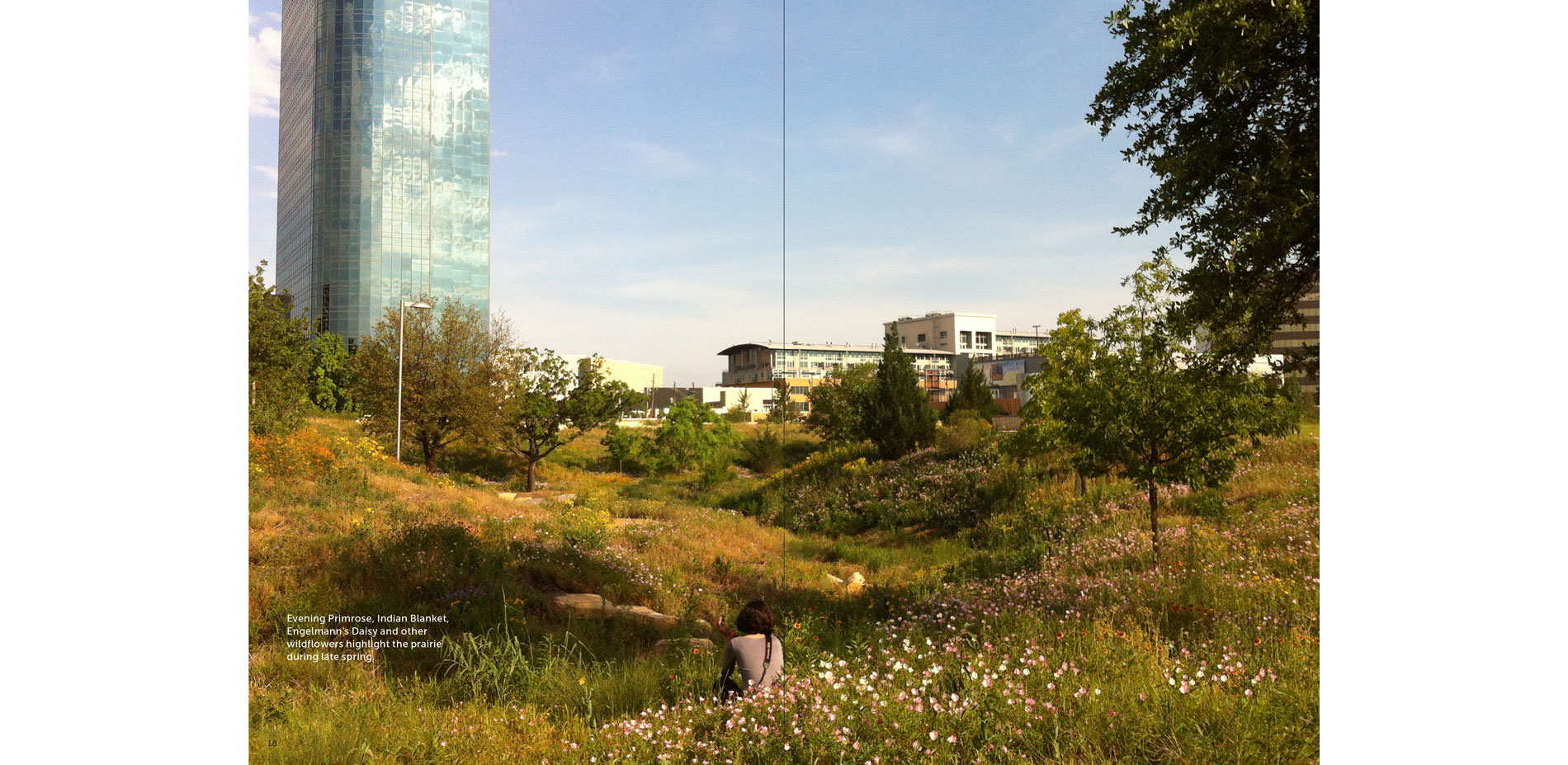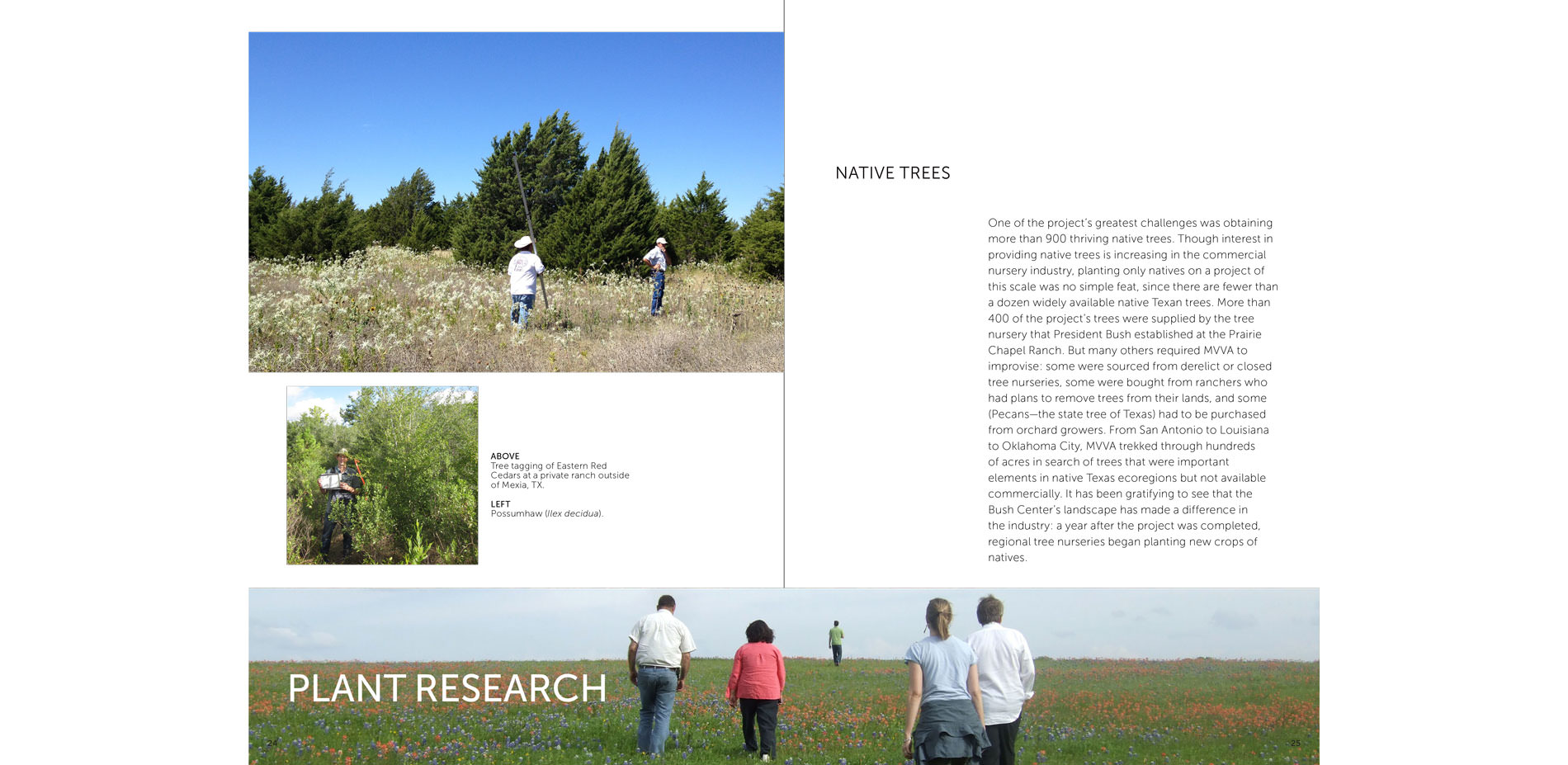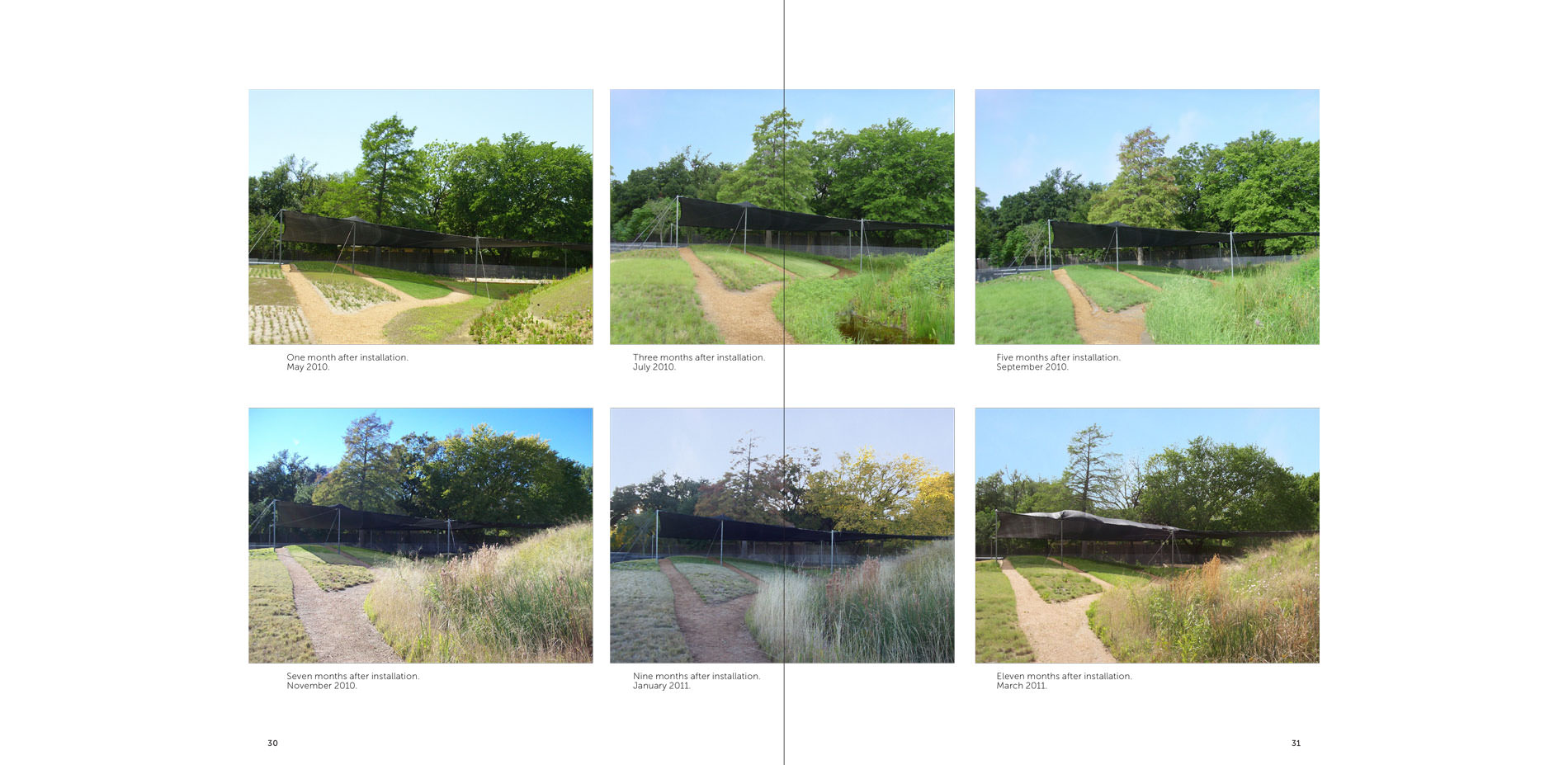Ecology as the Inspiration for a Presidential Library Park
Honor
Communications
Dallas, TX, USA | Michael Van Valkenburgh Associates, Inc.| Client: George W. Bush Presidential Center
This one is really impressive and is actually communicating how landscape design and a scientific approach are dealing with these unique ecologies.
- 2017 Awards Jury
PROJECT CREDITS
DESIGN TEAM
- Michael Van Valkenburgh Associates, Inc.
- Landscape Architect
- Lady Bird Johnson Wildflower Center
- Prairie Consultant
- Sustainable Growth Texas/Soils Alive
- Prairie Consultant
- Olsson Associates
- Soil Scientist
- Jeffrey L. Bruce and Company
- Irrigation Designer
- Walter P. Moore
- Structural Engineer
- URS Corporation
- Civil Engineer
GEORGE W. BUSH FOUNDATION
- Mark Langdale
- President of the Bush Foundation
- Peter Arendt
- Director of Design and Construction
- Jeff Innmon
- Project Manager of Landscape Construction
CONTRACTORS
- Manhattan Constructon Group
- Construction Manager/General Contractor
- Metheny Landscape
- Landscape Contractor
- Southern Botanical Inc.
- Landscape Contractor
- Environmental Design Inc.
- Tree Installation Contractor
- Lonestar Nurseries
- Tree Sourcing Contractor
PROJECT STATEMENT
The Landscapes of the George W. Bush Presidential Center is written for the general public with the goal of helping people understand how ecology and sustainability, particularly plants and stormwater, have shaped both the making of the park and their experiences when they visit. This book records the design thinking, ecological mission, technological underpinnings, and construction of the first native landscape built for a presidential library park. Transforming the Bush Center’s derelict urban site into a culturally rich, expressive, and ecologically operational landscape was a complex---and fascinating---undertaking that resulted in a 15-acre park of native Texas landscapes including blackland prairie, meadows, upland savannah forest, and more. Explanations are given about the methodologies, choices, and decisions that led to a comprehensive ecological intervention. Beautiful pictures of the maturing landscape, throughout the seasons, are interlaced with technical diagrams and construction photos that illustrate the process of making a living landscape, and help share the story of design and project delivery.
PROJECT NARRATIVE
It took six years and hundreds of decisions to design and build the Bush Center’s landscape. The Landscapes of the George W. Bush Presidential Center tells the intriguing backstory of changing a derelict and lifeless parcel into a thriving piece of nature that reflects the personal passions of the President and First Lady. This book was written for the public with the ambition of revealing what designed landscapes can do when ecological goals coincide with civic opportunities to challenge traditional park-making. What follows is an abridged version of the information it provides.
The Inspiration
The design of the landscape of the George W. Bush Center began with the idea that, in the popular imagination, the President is closely identified with the native Texas landscape.
- During his time in office, President Bush was often photographed, in boots and hat, against the backdrop of his Prairie Chapel Ranch in Crawford, Texas, which was considered his “Western White House.”
- In 2001, President and Mrs. Bush undertook an ambitious 150-acre prairie restoration at Prairie Chapel Ranch. This required years of plowing to eradicate invasive plants and seeds, several subsequent years of seeding and reseeding for establishment, and ongoing management.
- The 15-acre Bush Center is the first presidential library to install a native landscape. It was designed to reflect President and Mrs. Bush’s love of the native Texas landscape, their longstanding commitment to environmental conservation and restoration, and their belief that the Bush Center’s grounds should contribute to the everyday life of nearby communities and enhance the experience of visitors.
Constructing Native Ecologies in the City
- Creating a sustainable landscape on this site had its challenges, in large part because the new park would need to re-engage long dormant and profoundly disturbed natural systems.
- Before development, the site was almost entirely paved; today almost 75% of the site is unpaved.
- One hundred thousand cubic yards of fill from on-site building excavations were reused to create new topography.
- The new hills and valleys create microclimates with distinct balances of sun, water, and wind to enable establishment of different ecological zones.
- Soil texture, grading, and biology had to be carefully designed to support the needs of native plants and create an organically maintained fertility that will increase with time.
- All rainwater is managed and reused. Parking lots and planted areas flow to overland bioswales that slow and clean water. Forebays settle out sediments, a seep delays stormwater release, and all site water drains toward the Wet Prairie, where it is cleansed and slowly infiltrated into an underground irrigation tank. The highly efficient irrigation system operates only when needed.
Cultivating Native Texas Landscape Types
In addition to having symbolic power and rugged beauty, the native ecologies at the Bush Center increase biodiversity, restore native habitat, and limit extensive irrigation.
- The landscape features networks of native landscape types such as Blackland Prairie, Post Oak Savannah, and Cross Timbers Forest.
- The wildflower meadow provides an in-town opportunity to participate in a long-standing cultural pilgrimage to see springtime blooming of Bluebonnets.
- The nine acres of lawn at the Bush Center are a mixture of native short prairie grasses that are drought tolerant, need little mowing, and require minimal fertilization. The mix was developed through years of research and trials by the Lady Bird Johnson Wildflower Center with the goal of demonstrating a viable alternative to typical cultivated turf. This is the first large-scale implementation of this seed mix. Over 900 native species trees were planted to give habitat for fauna and shade for visitors.
- The Texas Rose Garden outside of the replica Oval Office pays homage to the White House Rose Garden and is made from native plants chosen for their similarity to their counterparts in Washington.
- The Ceremonial Courtyard within the museum is a West Texas landscape of succulents, Chitalpa Pink Dawn trees, and native perennials.
- This is the first presidential library to be organically maintained.
Plant Research
The landscape architect sought to create a landscape that was more than a collection of beautiful plants; the planting strategy at the Bush Center helps restore a functional ecology to the site.
- Finding more than 900 native trees was difficult due to lack of commercial availability.
- More than 400 of the project’s trees were supplied by the tree nursery established by President Bush at the Prairie Chapel Ranch.
- Sourcing other trees required improvising, such as visiting derelict or closed tree nurseries, buying trees from ranchers who had plans to remove trees from their lands, and purchasing Pecans (the state tree of Texas) from orchard growers.
- The prairies have 37 species of grasses and 53 species of forbs, to let species fill the various microclimatic niches created by different combinations of wind, moisture, sunlight, and topographic conditions.
- An 8,150 square-foot mock-up made 15 months before landscape construction began provided invaluable information. Every aspect of the proposed design was replicated including soil, plant palette, topography, and watering. The site conditions were also duplicated with the same solar aspect, shade conditions, and drainage patterns. Plots of commercial turf and native “lawn” were installed to compare their growth in both sun and shade.
Sustainable Sourcing of Stone and Wood
Incorporating regional materials helps create culturally meaningful landscapes and contributes to a project’s environmental stewardship, since it reduces transportation activities and their pollution.
- Indigenous Leuders Limestone from Abilene, Texas is used in different forms and finishes.
- Beautiful and extremely durable, sustainably-grown Black Locust wood is used to deck the bridges Appendix
The Appendix contains a complete list of plants, photographs of seasonal flowers, and identifies the project team, resources, and references.
